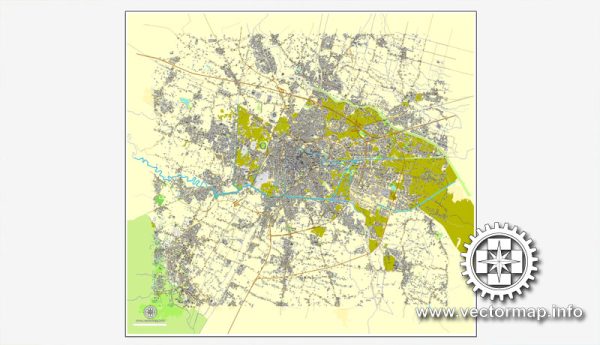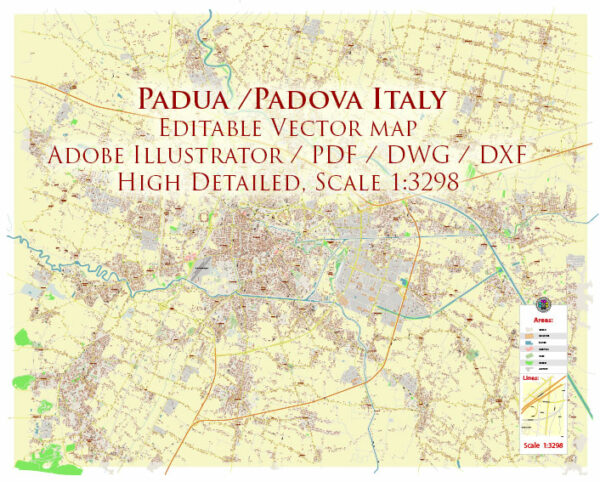Padua, located in the Veneto region of northern Italy, is a city rich in history and culture.
Vectormap.Net provide you with the most accurate and up-to-date vector maps in Adobe Illustrator, PDF and other formats, designed for editing and printing. Please read the vector map descriptions carefully.
Here is a detailed description of some of its historic places, buildings, streets, and squares:
- Basilica di Sant’Antonio (Basilica of Saint Anthony):
- This is one of the most important religious sites in Padua, dedicated to Saint Anthony of Padua, a beloved Franciscan saint.
- The basilica is a masterpiece of Gothic and Byzantine architecture, with its domes, spires, and intricate ornamentation.
- Inside, visitors can admire numerous works of art, including frescoes and sculptures by renowned artists.
- Cappella degli Scrovegni (Scrovegni Chapel):
- A gem of medieval art, the Scrovegni Chapel is renowned for its frescoes by the Italian master Giotto.
- The interior is adorned with vibrant scenes depicting the life of Christ and the Virgin Mary, showcasing Giotto’s innovative approach to storytelling through art.
- Prato della Valle:
- This is one of the largest squares in Italy and Europe, known for its elliptical shape and a central island surrounded by a canal.
- Lined with statues of historical figures, the square is a popular gathering place and often hosts events, markets, and festivals.
- Palazzo della Ragione:
- A medieval town hall located in the heart of Padua, this palace is known for its massive wooden roof and large hall, which once served as the city’s courthouse.
- The building is adorned with frescoes, including a famous astrological clock.
- Palazzo Bo:
- The historic seat of the University of Padua, Palazzo Bo is a Renaissance building with a rich history.
- Galileo Galilei taught at the university, and visitors can explore the Anatomy Theatre, where dissections were once performed for medical students.
- Piazza dei Signori:
- This is one of the main squares in Padua, surrounded by historical buildings and monuments.
- The square is home to the Clock Tower, the Palazzo del Capitanio, and the Loggia del Consiglio, each contributing to the rich architectural tapestry of the area.
- Orto Botanico di Padova (Botanical Garden of Padua):
- Established in 1545, this is the world’s oldest academic botanical garden still in its original location.
- The garden is a UNESCO World Heritage Site and is home to a vast collection of plants, as well as historical greenhouses and structures.
- Duomo di Padova (Padua Cathedral):
- The cathedral is an important religious site with a mix of architectural styles, including Romanesque, Gothic, and Renaissance elements.
- Inside, visitors can see artworks by artists like Titian and Giusto de’ Menabuoi.
- Via Roma and Via Umberto I:
- These are two of the main streets in Padua, lined with shops, cafes, and historical buildings.
- Strolling along these streets offers a glimpse of daily life and architectural treasures.
Padua’s historic sites, buildings, streets, and squares collectively reflect the city’s rich cultural heritage and make it a fascinating destination for history enthusiasts and tourists alike.



 Author: Kirill Shrayber, Ph.D.
Author: Kirill Shrayber, Ph.D.